|
TennisOne Lessons The “Roll” Model Doug King Perhaps the most discernible difference in the so called modern game is the amount of spin that the players put on their shots. You could argue that Rod Laver was the first to introduce spin as a style of play that transcended all surfaces. With his heavily spun groundstrokes he showed that this could be as effective a style of play at Wimbledon as at Roland Garros. Borg was equally competent on these two divergent surfaces, employing a more traditional clay court style of baseline play to win a record number of modern era consecutive titles at Wimbledon (5). Of course other players were acknowledged “spin masters” but it was the way that Laver and Borg dominated the game that set them apart and made everyone take notice of spin as such an essential part of the game.
Today’s players, whether it is Federer or Nadal, Henin-Hardene or Mauresmo, all incorporate spin as an integral part of their games. Coaches, as well, endorse the advantages of topspin and slice. Spin will allow you to manipulate trajectory and bounce, vary the speed, and generally create havoc with your opponent’s judgment and timing. We see it used on all levels of play and on all surfaces. The advent of topspin has literally changed the way the game is played by the pros. Players advance to the net with much less regularity and much more trepidation as dipping passing shots and topspin lobs make net attacks much more risky. The changes in the game have been directly related to the degree of spin that today’s players are able to generate. It is truly the defining characteristic of the modern game. Spin has the obvious effect of changing the flight and the bounce of the ball but I would suggest that there is an even more important underlying principle to spin that supersedes the effects on trajectory and rebound, and that is the fundamental nature of contact. To spin a ball changes the entire nature of the tennis swing. It changes a slapping feel into a smoother brushing action, a hit into a controlled roll. Not only is spin the defining characteristic of the modern game, it could well be considered one of the most important aspects that differentiates the stroke of tennis from other similar games. Roll the Ball vs Spin the Ball As a coach I like to introduce the concept and feel of spin as early as possible, however I prefer to begin with the notion of “rolling the ball” instead of “spinning the ball.“ It may be a minor distinction but the reason I prefer to express it as rolling instead of spinning is because first of all the ball is round and to move round objects we naturally roll them. Secondly, when we think of rolling a ball there is an implied object of destination that we are focused on; that is, we are rolling the ball somewhere. Spinning the ball does not necessarily have this same association. I can spin a globe or spin a top and I am not trying to get it to move from one point to another, I am simply trying to get it to spin.
The difference in these terms becomes more apparent when you see that as people are introduced to the concept of spin their early attempts usually result in heavily chopped volleys or wildly whipped groundstrokes. They are quite successful in getting the ball to spin but they don’t equate the spin with forward propulsion and forward direction. Rolling the ball, however, is somewhat different. The spin is more equated with a technique of getting the ball to go to a target. The spin is a means to an end (to move the ball to a target) rather than an end in itself. Certainly the skill of properly applying the correct amount of spin still takes time to develop but anything that can get the student to develop the skill faster and easier is better. This expression of “rolling” the ball also has implications in how we develop strategies of learning spin control, as we will look at later in this article. The Mechanics of Rolling When we look at the mechanics of rolling a ball we will actually see that the most commonly held notions of tennis teaching and learning models are diametrically opposed to producing a controlled, efficient rolling action. In traditional models the way we often describe the racquet take-back, swing, and follow through, the way we encourage the set up of the body and the weight shift, are all designed to get the racquet to build up momentum and hit against the ball. This will never produce a proper roll of the ball and thus you will always end up with a much less controlled hit on the ball. Now this may be fine for a sport like baseball where you have slap hitters, or squash where there is a wall to bash the ball against but in tennis, this kind of contact will end up spraying balls into the fences.
In a good tennis stroke with a proper spin or roll of the ball, the racquet must be “managed” and not swung. You must be able to bring the racquet to the ball in such a way as to encourage a “connection” between the ball and the racquet as opposed to a separation of the ball and racquet. I like to tell my students to use the racquet to get the ball to stick into your hand. I try to emphasize the association of “contact” and “connection.” Good hands will manage the racquet in a way that will absorb the shock of contact, create a “holding” feel, and take the hitting out of stroking. When we see players loosen their grips and relax their wrists in the backswing this does not mean they are whipping the racquet or snapping their wrists at the ball. Instead, they are timing a laying back and absorbing action into and through the contact. This loosening allows the body to maintain a free and dynamic flow of energy while the hand is still doing the proper job of absorbing, holding, and rolling the ball. The swing is in the body and the arms but not in the hands or racquet. The racquet can go very quickly in a way that applies a forceful “roll” on the ball but this is very different than applying a fast and forceful “hit” on the ball. How to Roll Rolling a ball is not as simple as you may think. Ask any golfer and they will tell you that it is a lot harder than it looks. In tennis we face the same issues in stroking and rolling the tennis ball as a golfer does when putting. A very effective way to study the mechanics of rolling or spinning a ball in tennis is to start by using the hand as a model. After all, the object in tennis is to get the racquet to respond and feel just like your hand. Most people, when asked to roll a ball, will place their hand on the top of the ball and brush their hand over and across the top in a sweeping action. This will actually cause it to spin off line. This is exactly how most people swing when they try to impart topspin. They smother over the top of the ball and they come across it. In attempting a topspin stroke, most people will turn the top edge of the racquet over the bottom edge while throwing the tip of the racquet in front of the handle. This results in a closed racquet face with the tip of the racquet pointing in the intended direction of the ball. It is exactly the opposite movement of what you should strive for. The correct motion is to push the racquet up and away from the body exerting pressure in the handle while slightly laying back the tip of the racquet. At the same time, you should lift up and push forward with the bottom edge of the racquet as you follow through. To understand and feel the proper technique, simply place a tennis ball on a table top or railing (see video on left) and try to make a perfect rolling action along a straight line using the palm of your hand. Most people will put their hand on the top of the ball and brush over it with a motion that ends up pointing the fingers in the direction of the roll. This will not give you a good roll. Instead, place your hand under the ball and push up with the heel of your hand. Keep the tips of your fingers back slightly, and feel the bottom edge of your hand (or pinky finger) make contact with the back of the ball. This will require a slightly "open" hand position. This method will give you a consistent, accurate, and solid forward roll of the ball." In tennis, the racquet works exactly like the hand. Once you get the feel of how your hand should truly roll a ball, it is relatively easy to translate that into a tennis swing. The problem is, we really don’t know the specific mechanics of how even our hand should work in producing a proper rolling action. This is further misconstrued by what we think we see by the top pros. We are so deceived by the speed at the top levels of the game and the apparent twisting action that we fail to see how solid this movement actually is. Forward Propulsion and Weight Shift Sometimes we hear that the body is not that involved in the powering of the ball. In fact my old coach, Tom Stowe, frequently liked to say “Get your body out of the shot.” But, as he explained, he never meant the body was not involved in the shot. What he really meant was “Get your body out of the way” of the contact. Most people are too anxious to get the racquet to swing at the ball that they use their bodies to help the racquet to increase it’s swing into the contact. This causes the body to pitch forward prematurely and creates an improper alignment between the body and racquet at contact. We commonly see this as a shift of the weight to the front foot on the forehand side before contact has occurred. This produces a cramped feel through contact and a weak, unsupported wrist. When this happens the body is not only underutilized as a means of proper support and stability, it actually acts as an obstruction to the proper extension of the arm through contact. The result is a loss of power and accuracy. Therefore, what we often see is that when people make great effort to get their bodies into the shot, they only get their bodies in the way of the stroke. Hence the phrase "get your body out of the shot!" The body should be behind the racquet at contact in order to provide support and proper propulsion (We will look more closely at the mechanics of how the body should supply power in the next article.). It is, in fact, the body that is doing most of the work in powering the ball. What is also critical to remember is that the arm is part of the body. The arm(s) go back and forth but not to swing the racquet. The body swings the arms and the hand is attached to the arm but the hand does not swing the racquet. The hand must direct the racquet to produce a proper roll of the ball. The hand has an entirely different role in the stroking process. This is why we refer to some players as having “good hands.” They can manage the dual function of the body which provides forward propulsion and the hands which create alignment, connection, and rolling of the ball with the racquet; what I sometimes refer to as “catching and turning.” If you study the adjoining video (right), you will see how I like to introduce the feel and technique of this dual function of propulsion from the body and connection from the racquet. Using a big, rubberized exercise ball, I first have someone take a hard swing at the ball from a forehand position. What they will feel is a huge shock, what they will hear is a loud bang, and what they will produce is very little movement of the ball. In this scenario there is a great deal of speed in the racquet but relatively no contribution from the body (other than to produce speed in the racquet). Next I have them hold the racquet at both ends and position the racquet directly in front of their bodies. I roll the exercise ball to them and while facing straight on to the ball, I have them stop the ball and then roll it back while grasping both ends of the racquet through the entire movement. What they feel is no shock, what they hear is no noise, and what they produce is a strong accurate, relatively effortless roll of the ball. In the second scenario the body is aligned in a very strong position to the racquet and hands (behind them) and the body is also very involved in the propulsion of the ball. The racquet has no momentum in itself but is totally passive to the turns, straightenings, and extensions of the body (knee and back straightening and arm extension). In a proper stroke these body moves must be sequentially timed so they are directly involved in the forward propulsion of the ball which allows the racquet to properly assume it’s role of aligning, connecting to, and rolling the ball. If the hands start to produce forward swinging action in the racquet we say that the player is “over swinging” or slapping at the ball. With this practice the student can easily get a sense of the “feel” of the stroke. They can even get a sense of what pros commonly develop and that is the ability to hear a proper stroke (no bang). They can also get a clearer understanding of the separate roles of the body and the hands and how power is truly produced. Now we can intelligently talk about getting your body into the shot and getting your body out of the shot at the same time. Racquet Travel Another illumination that you can gather from the above exercise is what I refer to as “racquet travel.” What I mean is how far does the racquet actually travel out beyond the ball and towards the target after contacting the ball. (This can also be described as the swing path or the swing plane.) We often talk about “hitting through the ball” and reaching out to the target. In fact in my last article I referred to the common visualization that pros use for students to “hit through a series of balls.” This is not a bad idea as it encourages people to avoid over swinging the racquet head but in reality this kind of a stroke will eventually produce flat pushes on the ball. When you do the exercise with the big ball you will feel that the racquet does not actually swing out to the target but instead just pushes up on the back of the ball. With the big ball, if you push forward on one point of the ball you will make the ball skid along the ground. In tennis we call this pushing the ball.
A good exercise to help understand how this forward versus upward racquet travel works is take a ball and set it on the edge of a table with just a tiny part of the ball overhanging the edge. Take your hand and roll up the overhanging edge and you will see you can produce quite a bit of forward power with relatively little forward momentum. Today we see professional players seemingly pulling the racquet backwards in order to minimize forward pushing, over swinging, and slapping at the ball. In fact, rolling the ball produces the most efficient contact and gives one the feeling of “holding the ball. The degree of spin, that is, how fast you roll the ball, is usually directly proportional to the amount of forward momentum that is coming into the ball. The more forward momentum produced from the body the more quickly the ball must be rolled or spun. These differences in swing speed and spin eventually develop into playing styles. Federer has a fast swing and considerable forward momentum coming into contact and therefore must “come off of the ball” quickly in order to control that momentum. Agassi has a more compact swing with less arm speed coming into contact, therefore he doesn’t need to come off the ball as fast and tends to hit a flatter ball. In both cases the racquet head is always managed the same way, that is, the hand manages the racquet in a way to produce a roll and avoid a hit or slap. Conclusion Tennis is ultimately a game of control. Physics will dictate that as the game speeds up and the ball is hit harder the only way to maintain consistency is through spin. This is not to say that more spin is better. I am not a believer in super heavy spin as the most effective or efficient playing style. Spin has its own risk built into it and so at some point in the equation more spin becomes a diminishing return. However, a properly produced roll of the ball is the most efficient way to hit the ball, the surest way to produce controlled power, and the best way to develop proper racquet and body mechanics. Remember, the racquet should be an extension of your hand so to begin learning the proper mechanics of rolling a ball, practice with your hand. Watch the pros in between points and you will frequently see them using their hands to mimic the position and action of this critical "rolling contact. The keys to remember are that the power comes from the body and is controlled in the feet and legs. The feet allow the body to wind and unwind, producing forward momentum in the shoulders and arms. The legs bend and straighten adding forward momentum in the hips. The control and roll of the ball is in the hands, they should be kept soft and the hands should minimize the back and forth swing of the racquet head. Practice the finer points of rolling a ball and try to apply them to your tennis stroke. Use this “Roll Model” and see if it doesn’t get your game on a roll. Your comments are welcome. Let us know what you think about Doug King's article by emailing us here at TennisOne.
Doug is one of the country's foremost tennis teaching innovators. Founder of Acceleration Tennis, a revolutionary teaching system, King is leading the way in reinterpreting the traditional tennis model. For more information on Acceleration Tennis please email Doug King at dking@meadowood.com. |

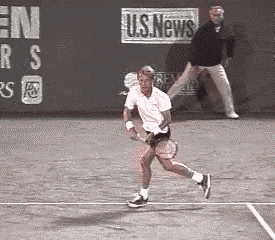
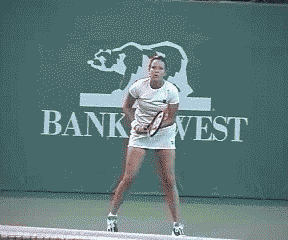
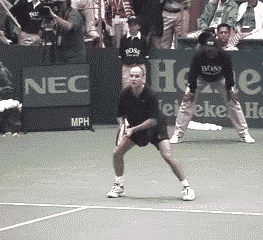

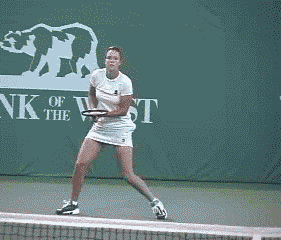
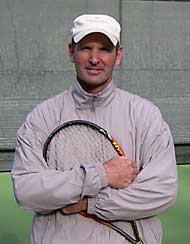
 Doug King studied with legendary tennis coach Tom Stow and was a
former California State Men's Singles Champion
and the former number one men's player of Northern California.
Doug King studied with legendary tennis coach Tom Stow and was a
former California State Men's Singles Champion
and the former number one men's player of Northern California.